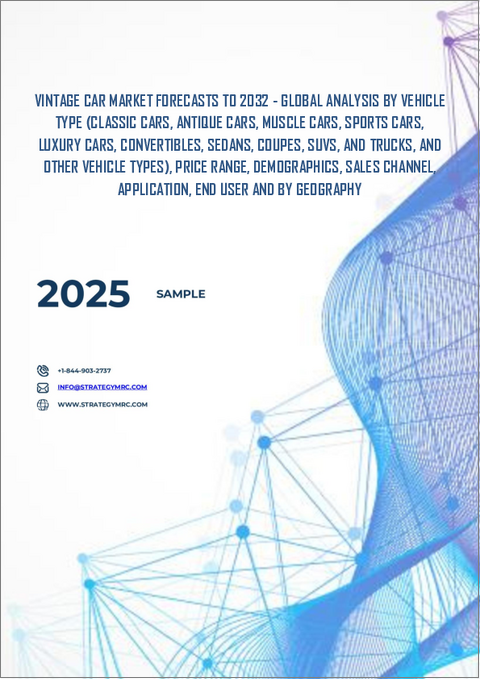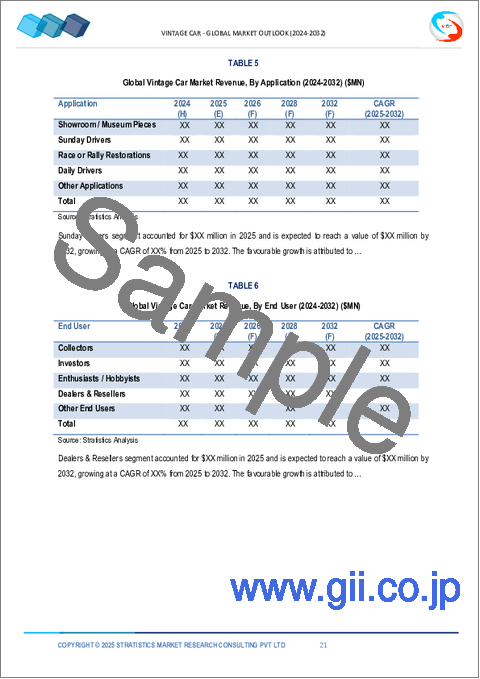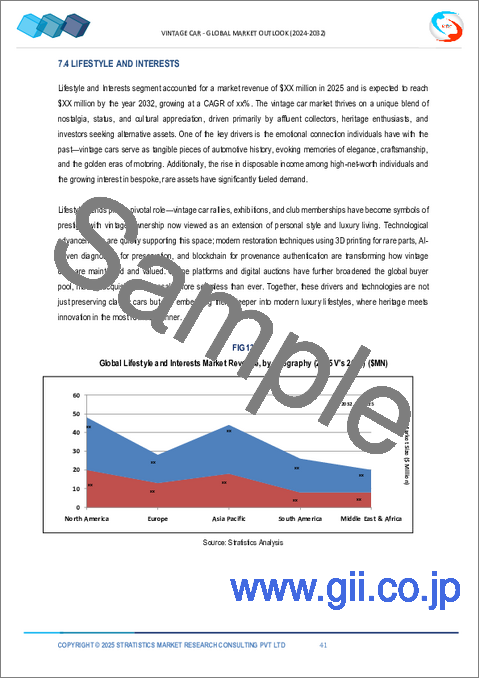|
|
市場調査レポート
商品コード
1725111
ヴィンテージカー市場の2032年までの予測: 車種別、価格帯別、人口動態別、販売チャネル別、用途別、エンドユーザー別、地域別の世界分析Vintage Car Market Forecasts to 2032 - Global Analysis By Vehicle Type, Price Range, Demographics, Sales Channel, Application, End User and By Geography |
||||||
カスタマイズ可能
|
|||||||
| ヴィンテージカー市場の2032年までの予測: 車種別、価格帯別、人口動態別、販売チャネル別、用途別、エンドユーザー別、地域別の世界分析 |
|
出版日: 2025年05月03日
発行: Stratistics Market Research Consulting
ページ情報: 英文 200+ Pages
納期: 2~3営業日
|
全表示
- 概要
- 図表
- 目次
Stratistics MRCによると、世界のヴィンテージカー市場は2025年に34億6,000万米ドルを占め、2032年には51億8,000万米ドルに達すると予測され、予測期間中のCAGRは5.9%です。
ヴィンテージカーは通常、1919年から1930年の間に製造された自動車と定義されるが、正確な範囲は地域によって異なる場合があります。これらの自動車は、自動車史における重要な時代を代表するものであり、初期のエンジニアリング、職人技、デザインを示すものです。ヴィンテージカーは、その希少性と歴史的価値からコレクターに珍重されています。クラシックカーやアンティークカーとは異なり、ヴィンテージカーは専門的なメンテナンスを必要とすることが多く、主に展示、パレード、または時折のレジャー走行に使用されます。
コレクターの関心の高まり
ヴィンテージカー市場は、クラシックカーの文化的、歴史的価値に後押しされ、コレクターの関心が急上昇しています。これらの自動車は、時代を超越した芸術品や工学作品とみなされ、富裕層や愛好家にアピールしています。ヴィンテージカーの供給は限られており、希少性も高まっているため、その需要はさらに高まっています。オンライン・プラットフォームやオークションの人気の高まりは、コレクターがこれらの貴重な財産を入手することを容易にしました。さらに、可処分所得の増加により、より多くの人々がヴィンテージカーに投資できるようになりました。
技術的専門知識の欠如
ヴィンテージカーのレストアやメンテナンスには専門的な技術や知識が必要だが、それらはしばしば不足しています。多くのヴィンテージカーオーナーは、これらの車の複雑な細部を扱える専門家を見つけるのに苦労しています。オリジナルパーツが入手できないことが、レストアプロセスをさらに複雑にしています。熟練した労働力と希少な部品に関連する高コストは、潜在的な買い手を躊躇させる。さらに、ヴィンテージカー修復のための標準化されたトレーニング・プログラムがないため、適格な専門家のプールが制限されています。
拡大するカスタマイズとレストアの動向
ビンテージカーのカスタマイズとレストアの動向は勢いを増しており、大きな成長機会を提供しています。熱狂的なファンは、車の美的魅力と機能的魅力を高めるために、個人的な改造を求めるようになってきています。3Dプリンティングなどの技術の進歩により、希少なパーツを正確に複製することが容易になりました。また、レストアプロジェクトは、職人技と革新性を披露する場にもなっています。この動向は、ヴィンテージカークラブや自動車の遺産を称えるイベントのコミュニティの成長によって支えられています。
嗜好の世代交代
嗜好の世代交代はヴィンテージカー市場に潜在的な脅威をもたらします。若い世代はクラシックカーよりも先進技術を搭載した現代車を優先するかもしれないです。電気自動車の台頭と持続可能性への懸念は、ヴィンテージカーの需要にさらに影響を与える可能性があります。加えて、所有と維持にかかる高いコストが若い購買層を遠ざけるかもしれないです。市場は、ヴィンテージカーの文化的・歴史的意義をアピールすることで、新たなオーディエンスに適応しなければならないです。市場の長期的な存続のためには、若い世代の関心を育てることが重要です。
COVID-19の影響
COVID-19の流行はビンテージカー市場に様々な影響を与えました。当初のサプライチェーンの混乱と経済の不確実性は市場の活動を鈍化させました。しかし、パンデミックはビンテージカーのレストアやコレクションを含む趣味への再関心にもつながりました。オンライン・オークションとバーチャル・イベントは、ヴィンテージ・カーを売買する人気のプラットフォームとして登場しました。その後、市場は買い控え需要と可処分所得の増加によって回復しました。全体として、パンデミックはヴィンテージカー市場の回復力と適応力を浮き彫りにしました。
予測期間中、アンティークカー部門が最大となる見込み
アンティークカー分野は、歴史と職人技の象徴としてのアンティークカーの永続的な魅力により、予測期間中最大の市場シェアを占めると予想されます。コレクターや投資家は、これらの車のユニークなデザインや文化的意義に惹かれています。アンティークカーの入手可能台数が限られていることも、その価値と望ましさをさらに高めています。修復や保存の努力も、このセグメントの成長に寄与しています。
投資家セグメントは予測期間中最も高いCAGRが見込まれる
ヴィンテージカーが有利な投資資産として認知されつつあることから、予測期間中、投資家セグメントは最も高い成長率を示すと予測されます。希少でユニークなモデルの価値が高まっていることが、富裕層や投資会社を惹きつけています。オンラインプラットフォームやオークションにより、投資家はヴィンテージカー市場にアクセスしやすくなっています。さらに、ヴィンテージカーファンドやポートフォリオの人気が高まり、投資活動がさらに活発化しています。この動向は、代替資産としてのヴィンテージカーの金融的可能性を強調しています。
最大のシェアを占める地域
予測期間中、アジア太平洋地域は、この地域の豊かさと自動車遺産への関心の高まりにより、最大の市場シェアを占めると予想されます。中国、日本、インドなどの国々がヴィンテージカーの主要市場として台頭してきています。政府の強力なイニシアチブと文化保護への投資が市場の成長をさらに後押ししています。コレクターや愛好家の活気あるコミュニティの存在も、この地域のリーダーシップに貢献しています。
CAGRが最も高い地域:
予測期間中、北米地域は最も高いCAGRを示すと予測されます。これは、同地域の確立された自動車文化と豊かな人口がヴィンテージカー需要を牽引しているためです。特に米国はコレクターや投資家にとってホットスポットです。オンライン・プラットフォームやオークションの台頭により、買い手はヴィンテージカーへのアクセスが容易になりました。さらに、この地域のレストア専門家やイベントの強力なネットワークが市場の成長を支えています。
無料のカスタマイズサービス
本レポートをご購読のお客様には、以下の無料カスタマイズオプションのいずれかをご利用いただけます:
- 企業プロファイル
- 追加市場企業の包括的プロファイリング(3社まで)
- 主要企業のSWOT分析(3社まで)
- 地域セグメンテーション
- 顧客の関心に応じた主要国の市場推計・予測・CAGR(注:フィージビリティチェックによる)
- 競合ベンチマーキング
- 製品ポートフォリオ、地理的プレゼンス、戦略的提携に基づく主要企業のベンチマーキング
目次
第1章 エグゼクティブサマリー
第2章 序文
- 概要
- ステークホルダー
- 調査範囲
- 調査手法
- データマイニング
- データ分析
- データ検証
- 調査アプローチ
- 調査資料
- 1次調査資料
- 2次調査情報源
- 前提条件
第3章 市場動向分析
- 促進要因
- 抑制要因
- 機会
- 脅威
- 用途分析
- エンドユーザー分析
- 新興市場
- COVID-19の影響
第4章 ポーターのファイブフォース分析
- 供給企業の交渉力
- 買い手の交渉力
- 代替品の脅威
- 新規参入業者の脅威
- 競争企業間の敵対関係
第5章 世界のヴィンテージカー市場:車種別
- クラシックカー
- アンティークカー
- マッスルカー
- スポーツカー
- 高級車
- コンバーチブル
- セダン、クーペ、SUV、トラック
- その他の車種
第6章 世界のヴィンテージカー市場:価格帯別
- エントリーレベルのクラシック(25,000米ドル未満)
- ミッドレンジクラシック(25,000米ドル~100,000米ドル)
- ハイエンドクラシック(10万米ドル~25万米ドル)
- 超希少で象徴的なクラシック(25万米ドル以上)
第7章 世界のヴィンテージカー市場:人口動態別
- 年齢
- 収入レベル
- ライフスタイルと興味
- 家族のライフサイクル
第8章 世界のヴィンテージカー市場:販売チャネル別
- オンライン
- オフライン
第9章 世界のヴィンテージカー市場:用途別
- ショールーム/ 博物館の展示品
- サンデードライバー
- レースやラリーの修復
- 日常の運転
- その他の用途
第10章 世界のヴィンテージカー市場:エンドユーザー別
- コレクター
- 投資家
- 愛好家/趣味人
- ディーラーと再販業者
- その他のエンドユーザー
第11章 世界のヴィンテージカー市場:地域別
- 北米
- 米国
- カナダ
- メキシコ
- 欧州
- ドイツ
- 英国
- イタリア
- フランス
- スペイン
- その他欧州
- アジア太平洋
- 日本
- 中国
- インド
- オーストラリア
- ニュージーランド
- 韓国
- その他アジア太平洋地域
- 南米
- アルゼンチン
- ブラジル
- チリ
- その他南米
- 中東・アフリカ
- サウジアラビア
- アラブ首長国連邦
- カタール
- 南アフリカ
- その他中東とアフリカ
第12章 主な発展
- 契約、パートナーシップ、コラボレーション、ジョイントベンチャー
- 買収と合併
- 新製品発売
- 事業拡大
- その他の主要戦略
第13章 企業プロファイリング
- RM Sotheby's
- Barrett-Jackson
- Mecum Auctions
- Gooding & Company
- Bonhams
- Worldwide Auctioneers
- Hagerty
- Bring a Trailer(BAT)
- ClassicCars.com
- Hemmings
- Streetside Classics
- Big Boy Toyz
- Vintage Mechanical Works
- Global Vintage Cars
- Vintage & Classic Car Club Of India(VCCCI)
List of Tables
- Table 1 Global Vintage Car Market Outlook, By Region (2024-2032) ($MN)
- Table 2 Global Vintage Car Market Outlook, By Vehicle Type (2024-2032) ($MN)
- Table 3 Global Vintage Car Market Outlook, By Classic Cars (2024-2032) ($MN)
- Table 4 Global Vintage Car Market Outlook, By Antique Cars (2024-2032) ($MN)
- Table 5 Global Vintage Car Market Outlook, By Muscle Cars (2024-2032) ($MN)
- Table 6 Global Vintage Car Market Outlook, By Sports Cars (2024-2032) ($MN)
- Table 7 Global Vintage Car Market Outlook, By Luxury Cars (2024-2032) ($MN)
- Table 8 Global Vintage Car Market Outlook, By Convertibles (2024-2032) ($MN)
- Table 9 Global Vintage Car Market Outlook, By Sedans, Coupes, SUVs, and Trucks (2024-2032) ($MN)
- Table 10 Global Vintage Car Market Outlook, By Other Vehicle Types (2024-2032) ($MN)
- Table 11 Global Vintage Car Market Outlook, By Price Range (2024-2032) ($MN)
- Table 12 Global Vintage Car Market Outlook, By Entry-Level Classics (Less than $25,000) (2024-2032) ($MN)
- Table 13 Global Vintage Car Market Outlook, By Mid-Range Classics ($25,000 - $100,000) (2024-2032) ($MN)
- Table 14 Global Vintage Car Market Outlook, By High-End Classics ($100,000 - $250,000) (2024-2032) ($MN)
- Table 15 Global Vintage Car Market Outlook, By Ultra-Rare and Iconic Classics (Over $250,000) (2024-2032) ($MN)
- Table 16 Global Vintage Car Market Outlook, By Demographics (2024-2032) ($MN)
- Table 17 Global Vintage Car Market Outlook, By Age (2024-2032) ($MN)
- Table 18 Global Vintage Car Market Outlook, By Income Level (2024-2032) ($MN)
- Table 19 Global Vintage Car Market Outlook, By Lifestyle and Interests (2024-2032) ($MN)
- Table 20 Global Vintage Car Market Outlook, By Family Life Cycle (2024-2032) ($MN)
- Table 21 Global Vintage Car Market Outlook, By Sales Channel (2024-2032) ($MN)
- Table 22 Global Vintage Car Market Outlook, By Online (2024-2032) ($MN)
- Table 23 Global Vintage Car Market Outlook, By Offline (2024-2032) ($MN)
- Table 24 Global Vintage Car Market Outlook, By Application (2024-2032) ($MN)
- Table 25 Global Vintage Car Market Outlook, By Showroom / Museum Pieces (2024-2032) ($MN)
- Table 26 Global Vintage Car Market Outlook, By Sunday Drivers (2024-2032) ($MN)
- Table 27 Global Vintage Car Market Outlook, By Race or Rally Restorations (2024-2032) ($MN)
- Table 28 Global Vintage Car Market Outlook, By Daily Drivers (2024-2032) ($MN)
- Table 29 Global Vintage Car Market Outlook, By Other Applications (2024-2032) ($MN)
- Table 30 Global Vintage Car Market Outlook, By End User (2024-2032) ($MN)
- Table 31 Global Vintage Car Market Outlook, By Collectors (2024-2032) ($MN)
- Table 32 Global Vintage Car Market Outlook, By Investors (2024-2032) ($MN)
- Table 33 Global Vintage Car Market Outlook, By Enthusiasts / Hobbyists (2024-2032) ($MN)
- Table 34 Global Vintage Car Market Outlook, By Dealers & Resellers (2024-2032) ($MN)
- Table 35 Global Vintage Car Market Outlook, By Other End Users (2024-2032) ($MN)
Note: Tables for North America, Europe, APAC, South America, and Middle East & Africa Regions are also represented in the same manner as above.
According to Stratistics MRC, the Global Vintage Car Market is accounted for $3.46 billion in 2025 and is expected to reach $5.18 billion by 2032 growing at a CAGR of 5.9% during the forecast period. Vintage cars are typically defined as vehicles manufactured between 1919 and 1930, although the exact range can vary by region. These cars represent a significant era in automotive history, showcasing early engineering, craftsmanship, and design. Vintage cars are highly prized by collectors for their rarity and historical value. Unlike classic or antique cars, vintage vehicles often require specialized maintenance and are mainly used for display, parades, or occasional leisure driving.
Market Dynamics:
Driver:
Rising collector interest
The vintage car market is experiencing a surge in collector interest, driven by the cultural and historical value of classic automobiles. These vehicles are seen as timeless pieces of art and engineering, appealing to affluent individuals and enthusiasts. Limited supply and increasing rarity of vintage cars have further fuelled their demand. The growing popularity of online platforms and auctions has made it easier for collectors to acquire these prized possessions. Additionally, rising disposable incomes have enabled more people to invest in vintage cars.
Restraint:
Lack of technical expertise
The restoration and maintenance of vintage cars require specialized skills and knowledge, which are often scarce. Many vintage car owners struggle to find experts capable of handling the intricate details of these vehicles. The lack of availability of original parts further complicates the restoration process. High costs associated with skilled labor and rare components deter potential buyers. Additionally, the absence of standardized training programs for vintage car restoration limits the pool of qualified professionals.
Opportunity:
Growing customization & restoration trend
The trend of customizing and restoring vintage cars is gaining momentum, offering significant growth opportunities. Enthusiasts are increasingly seeking personalized modifications to enhance the aesthetic and functional appeal of their vehicles. Advances in technology, such as 3D printing, have made it easier to replicate rare parts with precision. Restoration projects also provide a platform for showcasing craftsmanship and innovation. This trend is supported by a growing community of vintage car clubs and events that celebrate automotive heritage.
Threat:
Generational shift in preferences
A generational shift in preferences poses a potential threat to the vintage car market. Younger generations may prioritize modern vehicles with advanced technology over classic automobiles. The rise of electric vehicles and sustainability concerns could further impact the demand for vintage cars. Additionally, the high costs of ownership and maintenance may deter younger buyers. The market must adapt by promoting the cultural and historical significance of vintage cars to appeal to new audiences. Fostering interest among younger generations is crucial for the long-term viability of the market.
Covid-19 Impact
The COVID-19 pandemic had a mixed impact on the vintage car market. Initial disruptions in supply chains and economic uncertainty slowed market activity. However, the pandemic also led to a renewed interest in hobbies, including vintage car restoration and collecting. Online auctions and virtual events emerged as popular platforms for buying and selling vintage cars. The market has since rebounded, driven by pent-up demand and increased disposable incomes. Overall, the pandemic highlighted the resilience and adaptability of the vintage car market.
The antique cars segment is expected to be the largest during the forecast period
The antique cars segment is expected to account for the largest market share during the forecast period, due to the enduring appeal of antique cars as symbols of history and craftsmanship. Collectors and investors are drawn to the unique designs and cultural significance of these vehicles. The limited availability of antique cars further enhances their value and desirability. Restoration and preservation efforts have also contributed to the segment's growth.
The investors segment is expected to have the highest CAGR during the forecast period
Over the forecast period, the investors segment is predicted to witness the highest growth rate, due to the increasing recognition of vintage cars as lucrative investment assets. The appreciating value of rare and unique models has attracted high-net-worth individuals and investment firms. Online platforms and auctions have made it easier for investors to access the vintage car market. Furthermore, the growing popularity of vintage car funds and portfolios has further boosted investment activity. This trend underscores the financial potential of vintage cars as alternative assets.
Region with largest share:
During the forecast period, the Asia Pacific region is expected to hold the largest market share due to the region's growing affluence and interest in automotive heritage. Countries like China, Japan, and India are emerging as key markets for vintage cars. Strong government initiatives and investments in cultural preservation further support market growth. The presence of a vibrant community of collectors and enthusiasts also contributes to the region's leadership.
Region with highest CAGR:
Over the forecast period, the North America region is anticipated to exhibit the highest CAGR, owing to the region's well-established automotive culture and affluent population drive demand for vintage cars. The United States, in particular, is a hotspot for collectors and investors. The rise of online platforms and auctions has made it easier for buyers to access vintage cars. Additionally, the region's strong network of restoration experts and events supports market growth.
Key players in the market
Some of the key players profiled in the Vintage Car Market include RM Sotheby's, Barrett-Jackson, Mecum Auctions, Gooding & Company, Bonhams, Worldwide Auctioneers, Hagerty, Bring a Trailer (BAT), ClassicCars.com, Hemmings, Streetside Classics, Big Boy Toyz, Vintage Mechanical Works, Global Vintage Cars, and Vintage & Classic Car Club Of India (VCCCI).
Key Developments:
In March 2025, RM Sotheby's and the Royal Automobile Club are delighted to announce the renewal of their partnership, with title sponsorship of the iconic London to Brighton Veteran Car Run to continue for another five years. RM Sotheby's is also delighted to support the exciting new Royal Automobile Club Woodcote Park Concours.
In February 2025, Gooding Christie's unveils its entire online catalogue for the upcoming Amelia Island Auctions, set to take place at the Omni Amelia Island Resort. The global market leader and celebrated auction house is delighted to present a number of offerings from the respected Fred Leydorf Collection, including the headlining lot of the sale, the 1955 Ferrari 375 MM Berlinetta.
Vehicle Types Covered:
- Classic Cars
- Antique Cars
- Muscle Cars
- Sports Cars
- Luxury Cars
- Convertibles
- Sedans, Coupes, SUVs, and Trucks
- Other Vehicle Types
Price Ranges Covered:
- Entry-Level Classics (Less than $25,000)
- Mid-Range Classics ($25,000 - $100,000)
- High-End Classics ($100,000 - $250,000)
- Ultra-Rare and Iconic Classics (Over $250,000)
Demographics Covered:
- Age
- Income Level
- Lifestyle and Interests
- Family Life Cycle
Sales Channels Covered:
- Online
- Offline
Applications Covered:
- Showroom / Museum Pieces
- Sunday Drivers
- Race or Rally Restorations
- Daily Drivers
- Other Applications
End Users Covered:
- Collectors
- Investors
- Enthusiasts / Hobbyists
- Dealers & Resellers
- Other End Users
Regions Covered:
- North America
- US
- Canada
- Mexico
- Europe
- Germany
- UK
- Italy
- France
- Spain
- Rest of Europe
- Asia Pacific
- Japan
- China
- India
- Australia
- New Zealand
- South Korea
- Rest of Asia Pacific
- South America
- Argentina
- Brazil
- Chile
- Rest of South America
- Middle East & Africa
- Saudi Arabia
- UAE
- Qatar
- South Africa
- Rest of Middle East & Africa
What our report offers:
- Market share assessments for the regional and country-level segments
- Strategic recommendations for the new entrants
- Covers Market data for the years 2022, 2023, 2024, 2026, and 2030
- Market Trends (Drivers, Constraints, Opportunities, Threats, Challenges, Investment Opportunities, and recommendations)
- Strategic recommendations in key business segments based on the market estimations
- Competitive landscaping mapping the key common trends
- Company profiling with detailed strategies, financials, and recent developments
- Supply chain trends mapping the latest technological advancements
Free Customization Offerings:
All the customers of this report will be entitled to receive one of the following free customization options:
- Company Profiling
- Comprehensive profiling of additional market players (up to 3)
- SWOT Analysis of key players (up to 3)
- Regional Segmentation
- Market estimations, Forecasts and CAGR of any prominent country as per the client's interest (Note: Depends on feasibility check)
- Competitive Benchmarking
- Benchmarking of key players based on product portfolio, geographical presence, and strategic alliances
Table of Contents
1 Executive Summary
2 Preface
- 2.1 Abstract
- 2.2 Stake Holders
- 2.3 Research Scope
- 2.4 Research Methodology
- 2.4.1 Data Mining
- 2.4.2 Data Analysis
- 2.4.3 Data Validation
- 2.4.4 Research Approach
- 2.5 Research Sources
- 2.5.1 Primary Research Sources
- 2.5.2 Secondary Research Sources
- 2.5.3 Assumptions
3 Market Trend Analysis
- 3.1 Introduction
- 3.2 Drivers
- 3.3 Restraints
- 3.4 Opportunities
- 3.5 Threats
- 3.6 Application Analysis
- 3.7 End User Analysis
- 3.8 Emerging Markets
- 3.9 Impact of Covid-19
4 Porters Five Force Analysis
- 4.1 Bargaining power of suppliers
- 4.2 Bargaining power of buyers
- 4.3 Threat of substitutes
- 4.4 Threat of new entrants
- 4.5 Competitive rivalry
5 Global Vintage Car Market, By Vehicle Type
- 5.1 Introduction
- 5.2 Classic Cars
- 5.3 Antique Cars
- 5.4 Muscle Cars
- 5.5 Sports Cars
- 5.6 Luxury Cars
- 5.7 Convertibles
- 5.8 Sedans, Coupes, SUVs, and Trucks
- 5.9 Other Vehicle Types
6 Global Vintage Car Market, By Price Range
- 6.1 Introduction
- 6.2 Entry-Level Classics (Less than $25,000)
- 6.3 Mid-Range Classics ($25,000 - $100,000)
- 6.4 High-End Classics ($100,000 - $250,000)
- 6.5 Ultra-Rare and Iconic Classics (Over $250,000)
7 Global Vintage Car Market, By Demographics
- 7.1 Introduction
- 7.2 Age
- 7.3 Income Level
- 7.4 Lifestyle and Interests
- 7.5 Family Life Cycle
8 Global Vintage Car Market, By Sales Channel
- 8.1 Introduction
- 8.2 Online
- 8.3 Offline
9 Global Vintage Car Market, By Application
- 9.1 Introduction
- 9.2 Showroom / Museum Pieces
- 9.3 Sunday Drivers
- 9.4 Race or Rally Restorations
- 9.5 Daily Drivers
- 9.6 Other Applications
10 Global Vintage Car Market, By End User
- 10.1 Introduction
- 10.2 Collectors
- 10.3 Investors
- 10.4 Enthusiasts / Hobbyists
- 10.5 Dealers & Resellers
- 10.6 Other End Users
11 Global Vintage Car Market, By Geography
- 11.1 Introduction
- 11.2 North America
- 11.2.1 US
- 11.2.2 Canada
- 11.2.3 Mexico
- 11.3 Europe
- 11.3.1 Germany
- 11.3.2 UK
- 11.3.3 Italy
- 11.3.4 France
- 11.3.5 Spain
- 11.3.6 Rest of Europe
- 11.4 Asia Pacific
- 11.4.1 Japan
- 11.4.2 China
- 11.4.3 India
- 11.4.4 Australia
- 11.4.5 New Zealand
- 11.4.6 South Korea
- 11.4.7 Rest of Asia Pacific
- 11.5 South America
- 11.5.1 Argentina
- 11.5.2 Brazil
- 11.5.3 Chile
- 11.5.4 Rest of South America
- 11.6 Middle East & Africa
- 11.6.1 Saudi Arabia
- 11.6.2 UAE
- 11.6.3 Qatar
- 11.6.4 South Africa
- 11.6.5 Rest of Middle East & Africa
12 Key Developments
- 12.1 Agreements, Partnerships, Collaborations and Joint Ventures
- 12.2 Acquisitions & Mergers
- 12.3 New Product Launch
- 12.4 Expansions
- 12.5 Other Key Strategies
13 Company Profiling
- 13.1 RM Sotheby's
- 13.2 Barrett-Jackson
- 13.3 Mecum Auctions
- 13.4 Gooding & Company
- 13.5 Bonhams
- 13.6 Worldwide Auctioneers
- 13.7 Hagerty
- 13.8 Bring a Trailer (BAT)
- 13.9 ClassicCars.com
- 13.10 Hemmings
- 13.11 Streetside Classics
- 13.12 Big Boy Toyz
- 13.13 Vintage Mechanical Works
- 13.14 Global Vintage Cars
- 13.15 Vintage & Classic Car Club Of India (VCCCI)





